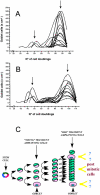Location and clonal analysis of stem cells and their differentiated progeny in the human ocular surface
- PMID: 10330405
- PMCID: PMC2133195
- DOI: 10.1083/jcb.145.4.769
Location and clonal analysis of stem cells and their differentiated progeny in the human ocular surface
Abstract
We have analyzed the proliferative and differentiation potential of human ocular keratinocytes. Holoclones, meroclones, and paraclones, previously identified in skin, constitute also the proliferative compartment of the ocular epithelium. Ocular holoclones have the expected properties of stem cells, while transient amplifying cells have variable proliferative potential. Corneal stem cells are segregated in the limbus, while conjunctival stem cells are uniformly distributed in bulbar and forniceal conjunctiva. Conjunctival keratinocytes and goblet cells derive from a common bipotent progenitor. Goblet cells were found in cultures of transient amplifying cells, suggesting that commitment for goblet cell differentiation can occur late in the life of a single conjunctival clone. We found that conjunctival keratinocytes with high proliferative capacity give rise to goblet cells at least twice in their life and, more importantly, at rather precise times of their life history, namely at 45-50 cell doublings and at approximately 15 cell doublings before senescence. Thus, the decision of conjunctival keratinocytes to differentiate into goblet cells appears to be dependent upon an intrinsic "cell doubling clock. " These data open new perspectives in the surgical treatment of severe defects of the anterior ocular surface with autologous cultured conjunctival epithelium.
Figures







References
-
- Barrandon Y. The epidermal stem cell: an overview. Dev Biol. 1993;4:209–215.
-
- Christiano AM, Uitto J. Molecular complexity of the cutaneous basement membrane zone. Revelations from the paradigms of epidermolysis bullosa. Exp Dermatol. 1996;5:1–11. - PubMed
-
- Compton CC, Gill JM, Bradford DA, Regauer S, Gallico GG, O'Connor NE. Skin regenerated from cultured epithelial autografts on full-thickness burn wounds from 6 d to 5 yr after grafting. A light, electron microscopic and immunohistochemical study. Lab Invest. 1989;60:600–612. - PubMed
Publication types
MeSH terms
Grants and funding
LinkOut - more resources
Full Text Sources
Other Literature Sources

